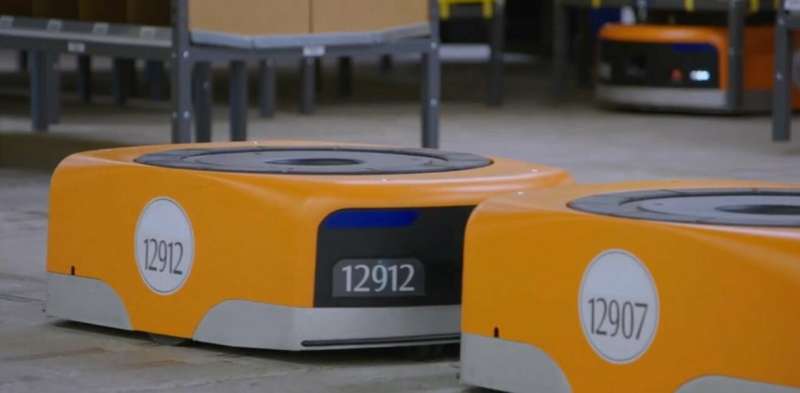January 20, 2019 weblog
Amazon's safety wearable is for human-robot workspace

Idea: A safety wearable to alert robots that a human is nearby. Idea maker: Amazon Robotics. Goals: Less obstacle hassles involving robots and workers.
Actually, "hassles" lighten the real risks of potential warehouse collisions, and just think about it.
The Occupational Safety and Health Administration (OSHA) has thought about it, to the point of examining studies on the topic:
"Studies indicate that many robot accidents occur during non-routine operating conditions, such as programming, maintenance, testing, setup, or adjustment. During many of these operations the worker may temporarily be within the robot's working envelope where unintended operations could result in injuries."
AJ Dellinger in Engadget recalled December reports of an incident at Amazon, when a robot punctured a can of bear repellant. The spray was released and some workers were affected by the spray.
Amazon Robotics, based in North Reading, Massachusetts, sits under the umbrella of Amazon.com and works on approaches to "order fulfillment solutions." According to the site description, it is "Amazon's largest east coast research and development organization." Technologies involved include autonomous mobile robots, control software, computer vision, depth sensing, machine learning, object recognition and semantic understanding of commands.
How the vest works: Sensors. They communicate with the robotic systems. The robots already carry obstacle avoidance detection tech, and the vest was designed to work in tandem with it.
Amazon Robotics VP Brad Porter told TechCrunch how the vest was different from robotic traffic planning. "In the past, associates would mark out the grid of cells where they would be working in order to enable the robotic traffic planner to smartly route around that region."
Porter said the vest allowed robots to detect a human farther away and steer clear "without the need for the associate to explicitly mark out those zones."
"On occasion, a human worker will need to enter an area primarily dominated by automated machines in order to perform maintenance or to pick up items that have fallen to the floor," said Dellinger. "With the vest on, robots can detect the human presence and adjust their behaviors. The bots will slow down and steer away from humans, allowing work to continue."
Cal Jeffrey reported in TechSpot that the Robotic Tech Vest was deployed by Amazon in over 25 sites so far. He described the wearable as "more like a belt with suspenders."
Brian Heater inTechCrunch said Amazon had begun rolling out the belt to sites last year. As a safety measure, they had in mind workers entering a space in order to fix a robotic system, or to retrieve fallen items.
Results so far? Amazon Robotics VP Brad Porter, according to reports, said tests of the vest have proven very successful.
In the bigger picture, researchers are raising awareness of the topic of robots in manufacturing settings vis a vis safety measures. A paper appeared in April, in Autonomous Robots, titled "Multi robot collision avoidance in a shared workspace."
Another paper, in International Journal of Mechanical Engineering and Robotics Research, appeared in March, titled "Human-Robot Collision Detection based on Neural Networks."
The authors wrote, "When the robots and humans share the same workspace, safety is very important factor because the proximity of the operator to the robot can lead to potential injuries so a system for safety based on collision avoidance or detecting the collision should be available."
They said that "Collision can be avoided by having the knowledge of the environment using vision or proximity sensors."
© 2019 Science X Network



















